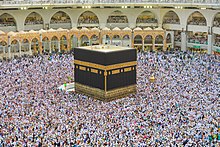اسلام کے مقدس ترین مقامات

اسلام کے مقدس ترین مقامات (انگریزی: Holiest sites in Islam) وہ مساجد اور عبادت گاہیں ہیں جن کا ذکر قران یا حدیث میں آیا ہے۔[2] حجاز میں موجود دو شہر مکہ،[3] اور مدینہ منورہ[4][5][6] بلا تفریق مسلک و عقیدہ سب سے نزدیک مقدس ترین شہر ہیں۔[1] اسلامی تعلیمات کے مطابق خانہ کعبہ خدا کا پہلا گھر ہے اور مقدس ترین عبادت گاہ ہے۔ خانہ کعبہ مکہ شہر میں واقع ہے جو پیغمبر محمد بن عبداللہ صلی اللہ علیہ و آلہ وسلم کی جائے پیدائش بھی ہے۔ خانہ کعبہ کے بعد دوسرا مقام مسجد نبوی کا ہے جو مدینہ منورہ میں واقع ہے۔ تیسری مقدس ترین مسجد حرم قدسی شریف ے جسے بیت المقدس اور مسجد الاقصی بھی کہتے ہیں جو یروشلم میں واقع ہے۔[2][7]
مذکورہ تین مقدس مساجد کے بعد چوتھی مسجد کے بارے میں کئی اقوال ہیں جن میں دمشق کی مسجد اموی،[8][9][10] قیروان کی جامع مسجد،[11][12][13] الخلیل کی مسجد ابراہیم،[14] اور ان کے علاوہ بخارا،[15][16] استنبول کے ضلع ایوب [17][18] اور برار میں بھی کئی مساجد ہیں۔[19][20]
حجاز
[ترمیم]حجاز جزیرہ نما عرب کا وہ علاقہ ہے جہاں مکہ اور مدینہ واقع ہیں۔ اسلام کے پیغمبر محمد بن عبداللہ صلی اللہ علیہ و آلہ وسلم کا تعلق بھی حجاز سے ہی ہے۔
مکہ
[ترمیم]اسلام میں مکہ[2] مقدس ترین شہر ہے کیونکہ یہ خانہ کعبہ اور مسجد الحرام کا مسکن ہے۔ [1] مسجد حرام میں صرف مسلمانوں کو ہی داخلہ کی اجازت ہے۔[21]
مکہ میں مسجد الحرام کے علاوہ جبل رحمت،[22] منی، مزدلفہ اور عرفات ہیں جہاں مسلمان حج کے ارکان ادا کرتے ہیں۔ حج 5 ارکان اسلام[23] میں سے ایک رکن ہے جسے ہر مستطیع مسلمان کو زندگی میں ایک بار ادا کرنا ضروری ہے۔[24] حج کو دنیا کی سب سے بڑی بھیڑ کا امیاز حاصل ہے جہاں 2012ء میں تقریباً 3 ملین افراد نے شرکت کی تھی۔ حج کے بعد کربلا، عراق میں روضہ امام حسین اور مسجد العباس میں عوام اکی جمع غفیر جمع ہوتا ہے۔ [25]
حوالہ جات
[ترمیم]- ^ ا ب پ Yaroslav Trofimov (2008)، The Siege of Mecca: The 1979 Uprising at Islam's Holiest Shrine (بزبان انگریزی)، New York، صفحہ: 79، ISBN 978-0-307-47290-8
- ^ ا ب پ Michigan Consortium for Medieval and Early Modern Studies (1986)۔ مدیران: Goss, V. P.، Bornstein, C. V.۔ The Meeting of Two Worlds: Cultural Exchange Between East and West During the Period of the Crusades۔ 21۔ Medieval Institute Publications, Western Michigan University۔ صفحہ: 208۔ ISBN 0-918720-58-3
- ↑ قرآن 48:22–29
- ↑ قرآن 9:25–129
- ↑ قرآن 33:09–73
- ↑ قرآن 63:1–11
- ↑ Mustafa Abu Sway۔ "The Holy Land, Jerusalem and Al-Aqsa Mosque in the Qur'an, Sunnah and other Islamic Literary Source" (PDF)۔ Central Conference of American Rabbis۔ 28 جولائی 2011 میں اصل (PDF) سے آرکائیو شدہ
- ↑ Janet L. Abu-Lughod (contributor) (2007)۔ "Damascus"۔ $1 میں Michael R. T. Dumper، Bruce E. Stanley۔ Cities of the Middle East and North Africa: A Historical Encyclopedia۔ ABC-CLIO۔ صفحہ: 119–126۔ ISBN 978-1-57607-919-5
- ↑ Damascus: What’s Left، Sarah Birke, New York Review of Books
- ↑ Totah, Faedah M. "Return to the origin: negotiating the modern and unmodern in the old city of Damascus." City & Society 21.1 (2009): 58-81.
- ↑ Berger, Roni. "Impressions and thoughts of an incidental tourist in Tunisia in جنوری 2011." Journal of International Women's Studies 12.1 (2011): 177-178.
- ↑ Nagel, Ronald L. "Jews of the Sahara." Einstein Journal of Biology and Medicine 21.1 (2016): 25-32.
- ↑ Harris, Ray, and Khalid Koser. "Islam in the Sahel." Continuity and Change in the Tunisian Sahel. Routledge, 2018. 107-120.
- ↑ Anita Vitullo (2003)۔ "People Tied to Place: Strengthening Cultural Identity in Hebron's Old City"۔ Journal of Palestine Studies۔ 33: 68–83۔ doi:10.1525/jps.2003.33.1.68 quote: From earliest Islam, the sanctuaries of Hebron and Jerusalem [al-Haram al-Ibrahimi and al-Haram al-Sharif] were holy places outranked only by Mecca and Medina; the Ibrahimi Mosque was regarded by many as Islam’s fourth holiest site. Muslims believe that the Hebron sanctuary was visited by the Prophet Muhammad on his mystical nocturnal journey from Mecca to Jerusalem.
- ↑ Jones, Kevin. "Slavs and Tatars: Language arts." ArtAsiaPacific 91 (2014): 141.
- ↑ Sultanova, Razia. From Shamanism to Sufism: Women, Islam and Culture in Central Asia. Vol. 3. IB Tauris, 2011.
- ↑ Okonkwo, Emeka E.، and C. A. Nzeh. "Faith–Based Activities and their Tourism Potentials in Nigeria." International Journal of Research in Arts and Social Sciences 1 (2009): 286-298.
- ↑ Mir, Altaf Hussain. Impact of tourism on the development in Kashmir valley. Diss. Aligarh Muslim University, 2008.
- ↑ Desplat, Patrick. "The Making of a ‘Harari’City in Ethiopia: Constructing and Contesting Saintly Places in Harar." Dimensions of Locality: Muslim Saints, Their Place and Space 8 (2008): 149.
- ↑ Harar – the Ethiopian city known as 'Africa's Mecca'، BBC, 21 جولائی 2017
- ↑ Tucker & Roberts 2008, p. 673.
- ↑ قرآن 2:124–217
- ↑ Musharraf 2012, p. 195.
- ↑ Peters 1994, p. 22.
- ↑ Blatt 2015, p. 27.


